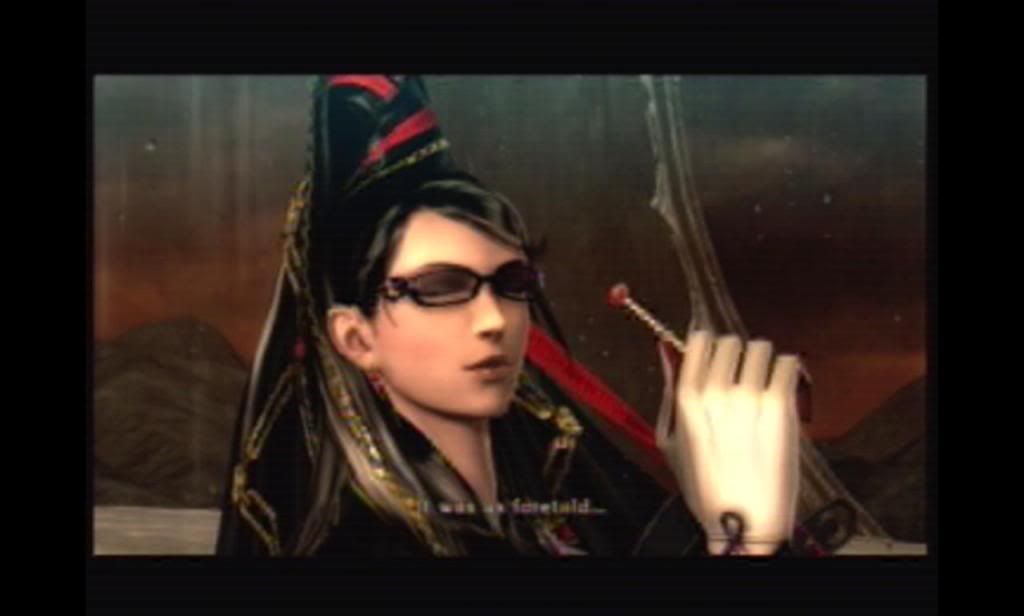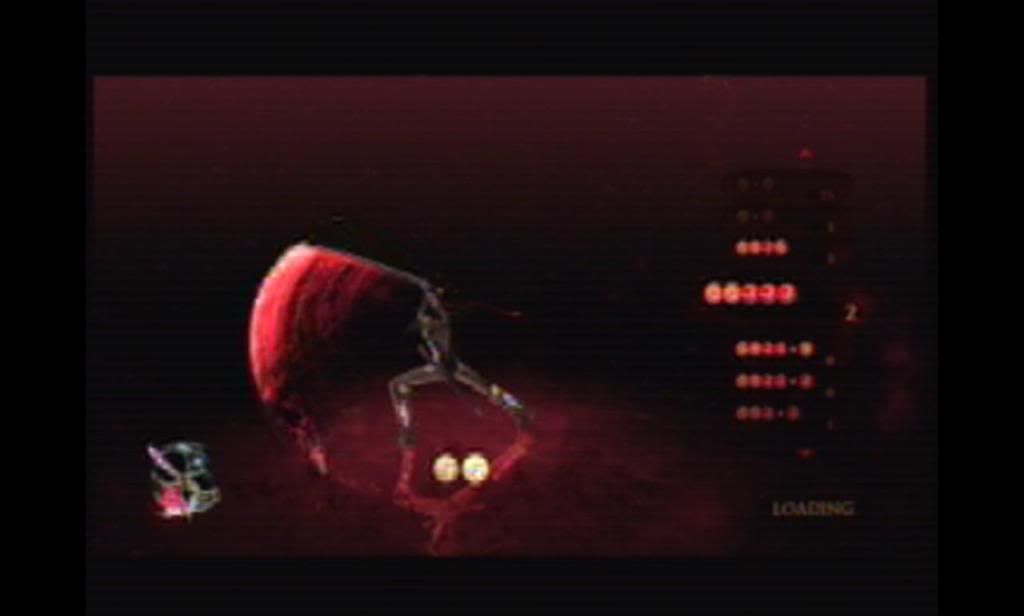Bayonetta is, without a doubt, one of the best action-brawler games on the market. Strictly speaking about gameplay, little of this game goes astray. Any fan of games like Devil May Cry or Ninja Gaiden will feel right at home with Bayonetta. This witch delivers fast, frantic gameplay that is very challenging, especially because of its introduction of, and emphasis upon a few unique mechanics. Even though Bayonetta will hold a very steep learning curve for newcomers to the action-brawler genre, most everyone will find a solid challenge. However, with all that can be said about it for its vigor and creativity, not everyone will fall in love with this witch; from its off-the-wall narrative to the absolutely crazy battle presentation, it will sadly fall to a niche market.
This game absolutely reeks of style; Baynetta’s strut, attacks, shadow, enemies, friends, cutscenes, upgrades, and power attacks all drip with a cutting creativity. I feel as though all the folks at PlatinumGames sat down and brainstormed all the things that would be cool to do in an action videogame, and then chose to incorporate all of these things. The magic is that Bayonetta’s amplified-fantasy context allows all of these indulgences to feel natural, rather than forced. The brilliant medium that allows all this imagination to flow uninhibited is her hair. Yes, that’s right – Bayonetta’s hair is a conduit for her magic, allowing her own body to assume the form of a malicious parrot-demon, a huge high-heeled foot that stomps down with great force, or a medieval guillotine. Whatever Bayonetta needs, she provides for herself with often humorous results; I don’t think I’ve ever laughed out loud or shouted cheers so often while witnessing the demise of an enemy.
 |
| Cockteasing... now a new subgenre. |
Platinum introduced us to Witch Time; the heir-apparent to bullet-time, except that the protagonist stays in full-speed motion while all the surrounding enemies slow down. While slow-mo game mechanics can feel unnatural or cliché if implemented poorly, one can only activate Witch Time after an exploit of skill. Rather than restricting slow-mo to a rechargeable or regenerative meter, it is activated in short intervals upon the player successfully dodging danger. The dodge button rests comfortably under the right index finger, and it is the only way to engage Witch Time. For example, a player laying into a baddie with one of Bayonetta’s often-long combos, if the enemy raises his axe to slash the player, he can press the dodge button right before the moment of impact and trigger a few seconds of Witch Time whoop-ass. It takes careful timing and is very dangerous, but is much more rewarding than what some similar games encourage, such as staying out of danger until the “special mode” meter fills back up. Being encouraged to jump right into the danger really keeps the battle pace exciting.
Bayonetta has her own version of special attacks as well. Dubbed “Torture Attacks,” these brief, but ridiculous, scripted sequences are contingent upon the player filling up the creatively-named “Magic Gauge” to one full sequence. The Magic Gauge is divided into eight circles, and said circles are filled by distributing pain. Appropriately, connecting more powerful attacks fill the gauge faster. Once all eight circles are gleaming bright, a simple button combination engages one of the many out-of-control Torture Attacks available, depending on which type of enemy is chosen as a victim. The stipulation about Torture Attacks that prevent them from being a cheap tactic is that once the player is struck, much of the Magic Gauge depletes. As the game progresses, the option exists to upgrade the number of circles in the Magic Gauge, which provides some leniency as the battles escalate in intensity, because Torture Attacks always require eight circles to activate.
The game plays a very effective game of risk vs. reward with the player. Filling up the Magic Gauge is a great way to distribute serious damage, especially to more dangerous and elusive foes. Witch Time is the most efficient and safest way to quickly fill the Magic Gauge, and is an effective means of laying down some hurt in its own right. Even with all these destructive tools at the players’ disposal, the only real way to power them up is to jump into the action and bring the fight, which makes for a fast-paced, multi-faceted game that rewards planning as well as skill and reflex.
Another new card brought to the table by Bayonetta is to have one weapon equipped to the hands, and another equipped to the feet - yes, the feet. While most weapons can be equipped to the hands, most of the downstairs potential rests with mounting ranged weapons. Two sets of weapons can be arranged via the start menu, and the left trigger button issues a weapon-set swap. This allows for four different weapons to be instantly available to the player with a simple button-tap, which allows for some surprising versatility, and projectile weapons are activated by simply holding in the punch or kick buttons for just a split second. With one weapon set, I am able to charge into an enemy with a pair of giant claws, and once they are knocked back I unleash a barrage from the ankle-mounted pistols. With one touch of a button, I’ve swiftly switched to the alternative weapon set, and am unleashing quadruple shotgun devastation, with one set on the hands and another set on the feet. Even if the situation calls for a weapon outside of the four that are immediately available, the start menu loads quickly and is simple to navigate.
 |
A good variety of weapons are available, and mixing-and-matching is encouraged to best suit both a player’s preferred style of play as well as situation-specific encounters with foes. While the weapons aren’t upgradeable, a good selection is available from the game’s store. Most of the weapons vary in speed and range, which gives them all a very unique feel and prevents the game from feeling homogenized. Some models of foe drop their own weapons, and while they all break very quickly, they all offer some generous damage-dealing capabilities and help keep the gameplay varied.
The game store offers a good variety of upgrades, as well as new weapons. Run-of-the-mill items like those that restore health and magic are included, but the other items range from mundane to killer, and can really change the player’s approach to a particularly challenging portion of the game.
If you haven’t yet deduced, Bayonetta hardly takes itself seriously. The game benefits all the more from this creatively directive choice, as some of the most imaginative sequences in the game don’t feel forced or strained; the canon will permit just about anything to happen. However, what is present of a narrative certainly does not benefit from the jovial tone of the game. The cutscenes carry a surprisingly serious tone, which makes for an unwelcome change of pace after I just finished killing hordes of angels with a shot-gun themed breakdance and an iron maiden.
The story that is present is decent, if bizarre, and is well-presented by both cutscenes and a creative sort of film-drawn comic book, but is really restrained by the tone that the game sets outside of the cutscenes. The lore is fleshed-out and elaborated upon by a variety of in-game documents that can be discovered while exploring the levels, but isn’t required reading by any means, and further understanding of the Umbra Witches and Lumen Sages hardly benefits the experience from beginning to end.
Puzzles and platforming range from obvious to infuriating. Implementation of Witch Time into the puzzles only mandates the use of reflexes in activation. Beyond manipulating time to traverse certain obstacles, standard item placement and activation of switches constitute the puzzles. Nothing profound, but as an action game the puzzles only exist as a slight change of pace. No puzzle is particularly complex.
Platforming is a mixed bag. Certain elements such as changing gravitational orientation, and transforming into a beast to run with great speed work very well and are welcome distractions from battling. Much to my dismay, however, the latter half of the game often includes jumping and running around on light-platforms which don’t display the player’s shadow. Such an exclusion really messes with depth perception, and often results in trials of tedium rather than of timing and coordination.
The boss battles of Bayonetta are simply pristine. High-quality boss battles occur every few levels. All of them are grand in scope, and feature unique mediums ranging from the middle of the ocean to an ancient coliseum. A great blend of all-out hacking to dodging and running are present, much like a Zelda-style boss battle at double speed. The demise of every boss is outrageous and hilarious.
 |
To wrap up, Bayonetta is an excellent action game, and sets a new bar for excitement. Honestly, it’s hard to go back to playing older action games after experiencing 20 hours of this smooth action, despite some minor platforming-related annoyances. The tone of the game is fun, and is a welcome change of pace from the all-too-common “serious” games on the market. Sadly, only a very open-minded gamer is going to get past the outrageous protagonist and insane style to be able to dive into the juicy gameplay. An oversexualized female protagonist aimed at male audiences is just too much of an aesthetic boundary for many to clear.
Bayonetta gets a B lettergrade.